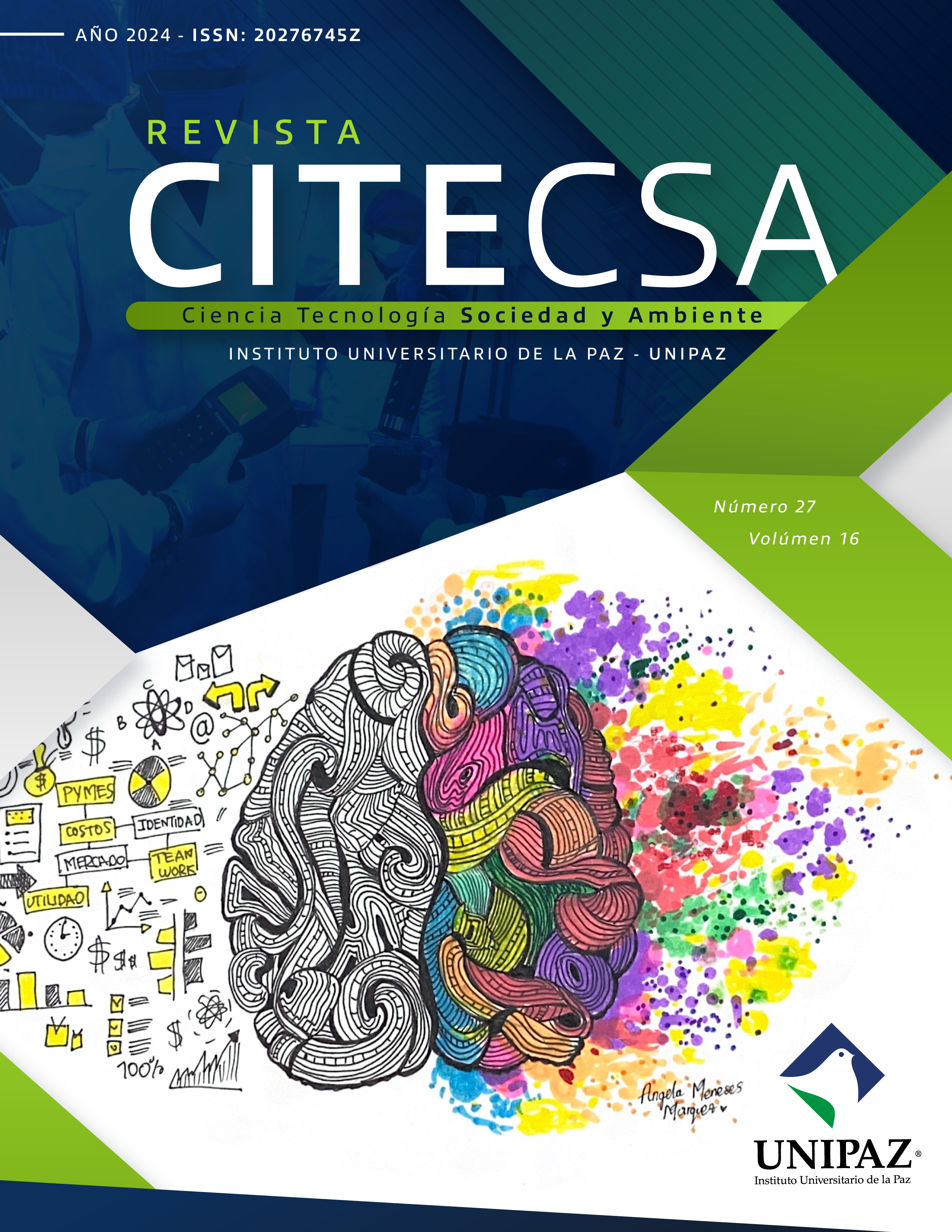Arts and culture for sustainability management at UNIPAZ
Keywords:
Arts and culture, sustainability management, Sustainable Development Goals (SDG).Abstract
The role of arts and culture in managing sustainability at UNIPAZ is based on definitions and background information drawn from the literature review, which established a conceptual framework to engage society in balancing the triad of the concept of sustainability. This approach is based on the Brundtland Commission and the Sustainable Development Goals (SDGs), which are essential in the process of balancing current needs without compromising those of future generations. This implies intergenerational justice, social equality and environmental protection, along with economic growth, which are fundamental pillars of business sustainability in relation to the SDGs. From a holistic perspective, arts and culture play a crucial role in sustainable development, facilitating diverse intercultural dialogues that generate an educational path for global citizenship, driven by creativity and innovation.
References
Arksey, H. O. (2005). Estudios de alcance: hacia un marco metodológico. Revista Internacional de Metodología de la Investigación Social, 8, 19-33. https://doi.org/https://doi.org/10.1080/1364557032000119616
Bertalanffy, V. (1973). Teoría general de sistemas: fundamentos, desarrollo, aplicaciones. 24.
Bruna, P. (2021). Arte y ecología política, un viaje desde el modelo antropocéntrico a las realidades no humanas. Universidad de Barcelona. https://doi.org/https://www.ub.edu/portal/web/bellasartes/doctorado
Brundland, G. (1.987). Nuestro futuro común. Comisión Mundial sobre Medio Ambiente y Desarrollo. Universidad de Oxford.
Celis, I. V. (27 de 10 de 2023). UNIPAZ. Manigua, Nativo y Selva. UNIPAZ, Caquetá, Colombia. https://www.youtube.com/watch?v=NHSoohtsqig
De la rosa, l. M. (18 de 1 de 2021). El enfoque de sostenibilidad en las teorías organizacionales. Transcender contabilidad y gestión, 16. https://doi.org/https://doi.org/10.36791/tcg.v0i17.102
Eco, U. (1.983). La definición del arte. España: Ediciones Martínez, Roca S.A.
Elkington, J. (25 de 6 de 2018). «25 Years Ago I Coined the Phrase “Triple Bottom Line.”. Harvard Business Review. Retrieved 29 de 4 de 2024, from https://hbr.org/
Fernández, E. V. (2022). Aproximaciones desantrópicas. Contrarelatos y desobediencias y visualidades. (p. javeriana, Ed.) Universidad javeriana, 17(2), 96-112. https://doi.org/https://doi10.11144/javeriana.mavae172.
Flórez, O. (2020). Sinergia entre arte y ecología, propuesta de intervención artística colectiva. UNIVALLE, 23. https://doi.org/https://bibliotecadigital.univalle.edu.co/handle/10893/18922
GEPXEMO. (2020). O-H+O:FORMAS PARA RESPIRAR. O-H+O:FORMAS PARA RESPIRAR. UNIPAZ, Barrancabermeja, Santander. https://www.youtube.com/watch?v=X-2X4cb-bYc&t=6s
GEXPEMO. (2017). Cuerpo Textual. Cuerpo Textual. UNIPAZ, Barrancabermeja, Santander, Colombia. https://www.youtube.com/watch?v=vH9POKiOC3I
Ketprapakorn, N. K. (2022). Teoría organizacional de la cultura de la sostenibilidad. (U. d. Escuela de Negocios, Ed.) www.elsevier.com/locate/spc, 18.
Lamesi, B. (1 de 2020). Arte ed ecologia: L'impronta francescana. Antoniaum, 225-253. https://dialnet.unirioja.es/servlet/articulo?codigo=7494530&info=resumen%20Le%C3%B3n,%20S%C3%A1nchez%20Nuria,%20(2018)%20La%20funci%C3%B3n%20del%20arte%20en%20procesos%20de%20transici%C3%B3n%20a%20la%20sostenibilidad:
León, S. N. (2018). La función del arte en procesos de transición a la sostenibilidad: casos anglosajones españoles. Dialnet. Retrieved 14 de 6 de 2024, from https://dialnet.unirioja.es/servlet/tesis?codigo=250512
Leopold’s, A. (1948). “The Land Ethic”. sciencedirect. https://doi.org/https://doi.org/10.1016/j.ecolecon.2014.10.018.
Marqúes, A. (2018). Arte comunitario: cohesión entre arte y ecología y educación. AUSART, 95-115. https://doi.org/10.1387/ausart.19466
Martínez, E. P. (11 de junio de 2011). La teoría del desarrollo humano y sustentable: hacia el reforzamiento de la salud como un derecho y libertad universal. (I. d. UANL, Ed.) SCIELO, 19(37). Retrieved 9 de 6 de 2024, from https://www.scielo.org.mx/scielo.php?script=sci_serial&pid=0188-4557&lng=es&nrm=iso
Mathevet, R. B. (2018). The concept of stewardship in sustainability science and conservation biology (Vol. 217). https://doi.org/https://doi.org/10.1016/j.biocon.2017.10.015.
Ochoa, E. A. (2015). Cultural industries and economic growth. A model to study the emergence of creative clusters. Sociedad y Territorio,, XV(47), 185-216.
ONU. (2014). La Economía Social y Solidaria el reto del desarrollo sostenible. Grupo de Trabajo Interinstitucional de las Naciones Unidas sobre Economía Social y Solidaria. Ginebra: ONU.
ONU. (2015). Agenda 2030. ONU. Retrieved 29 de 4 de 2024, from https://www.ONU.org
Orozco, I. (2020). De la ética empresarial a la sostenibilidad. The Anáhuac Journal: Business and Economics, 20(1). https://doi.org/https://doi.org/10.36105/theanahuacjour.2020v20n1.03
Ospina, H. (2010). Nuevos paradigmas de gestión humana. (U. p. bolivariana, Ed.) Revista de ciencias estratégicas, 18(23).
Ospina, H. (2010). Nuevos paradigmas de gestión humana. . (U. p. bolivariana, Ed.) Revista de ciencias estratégicas, 18(23).
Ospino, E. J. (11 de noviembre de 2020). Eficacia de las políticas públicas sociales, empresariales y. Revista Jurídica, 17.
Ostrom, E. (2010). El gobierno de los bienes comunes. (U. F. México, Ed.) Universidad nacional autónoma de México.
Ponce, ,. d. (2018). Guía de investigación en Gestión (Dirección de Gestión de la Investigación – DGI. ed.). Perú: Dirección de Gestión de la Investigación – DGI. Retrieved 2 de 5 de 2024, from http://investigacion.pucp.edu.pe/
Reddy, G. C. (2014). Environmental friendliness in manufacturing of traditional handicrafts: a new perspective. BS Publications, 18.
Ruiz Restrepo, C. (2000). Educación por el arte, de H. Read. Manizales: Universidad Nacional. https://repositorio.unal.edu.co/handle/unal/11828
Segura, O. J. (5 de 08 de 2021). Sistemas y aspectos de sinergia entre la economía. Dialnet, 44, 386-396. Retrieved 28 de 5 de 2024, from https://dialnet.unirioja.es/servlet/articulo?codigo=8668419
SOLER, R. M. (2014). Los latidos de la tierra (Vol. 10). España, Murcia: Artes, política e identidad. Retrieved 14 de 6 de 2024, from http://revistas.um.es/api
Stahel, W. (2016). Circular economy. Nature, 6-9.
UNESCO. (2022). Cultura y desarrollo sostenible: un potencial aún sin explotar. Retrieved 11 de 6 de 2024, from https://www.unesco.org/reports/reshaping-creativity/2022/es/cultura-desarrollo-sostenible-un-potencial-aun-sin-explotar
UNIPAZ. (2022). Obras de creación e Investigación. Barrancabermeja, Santander: UNIPAZ. https://unipaz.edu.co/omp/index.php/editorial/catalog/view/1/2/265
Vidal Marcilio, G., & SANTOS, I. (2021). La economía solidaria desde la perspectiva de las capacidades humanas de Martha Nussbaum. Secuencia – PPGD UFSC, 42(88). https://doi.org/https://doi.org/10.5007/2177-7055.2021.e75942
Downloads
Published
How to Cite
Issue
Section
License
Copyright (c) 2024 CITECSA

This work is licensed under a Creative Commons Attribution-NonCommercial-ShareAlike 3.0 Unported License.

Este obra está bajo una licencia de Creative Commons Reconocimiento-NoComercial-CompartirIgual 3.0 Unported.

